A well-known artist has been teaching visual art at Keelung Prison for five years.
Yan Shang-wen (嚴尚文) has painted in the traditional Japanese style known as gyotaku for 36 years.
Gyotaku, or fish printing, involves applying ink, paint or pigment to the relief side of a fish, which is then pressed onto paper or canvas.
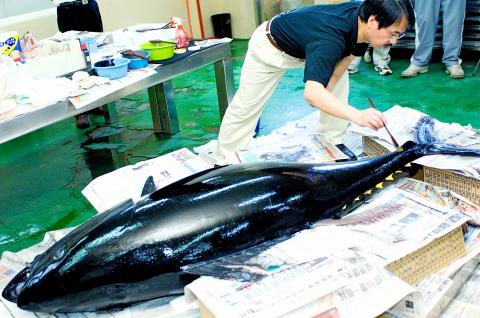
Photo: Wu Cheng-feng, Taipei Times
Yan’s works have sold for millions of dollars at auction and have been displayed at the Louvre Museum in Paris.
Five years ago Yan accepted a teaching position at the prison, which hopes to use art to help rehabilitate inmates.
“I am 62 years old. I wanted to act while I still have the ability to help people who nobody else has concern for,” Yan said.
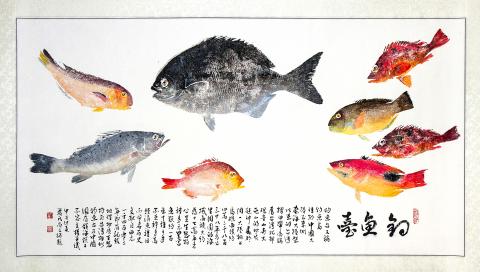
Photo: Wu Cheng-feng, Taipei Times
The Ministry of Justice in 2012 launched a program to promote special characteristics for each prison. Keelung Prison chose to feature the city’s fishing industry through gyotaku printing.
The ministry offered to pay Yan NT$1,600 per lesson.
“I felt that I had the opportunity to serve society, and at my age it was providence as well as my responsibility. I gladly accepted,” Yan said.
Yan has taught more than 100 inmates, only five of whom have been reincarcerated after their release.
Yan said classes demonstrate that marginalized people can develop self-confidence and a sense of achievement through art, adding that it can help with rehabilitation.
“For me, everything started with fishing,” Yan said.
Yan said he first made prints of his catches to record their size, the bait used and the time and place.
He later became interested in fish printing as an art form and started making prints with different numbers, colors and types of fish.
His art eventually gained Yan recognition nationwide.
In 2007 he was invited to make a 2m print of an Atlantic bluefin tuna for the annual Pingtung Bluefin Tuna Cultural Festival with then-president Chen Shui-bian (陳水扁), who drew the tuna’s eyes.
In 2014 Yan’s work was displayed at the Louvre Museum and the museum’s staff wore copies of his prints on their uniforms. The gyotaku print exhibit was the first of its size.
The value of gyotaku art is determined by how rare the fish is, as well as the quality of the print, Yan said.
Preparation takes a long time, but the printing takes five to 10 minutes, Yan said, adding that patience is very important to the process.
“Learning to enter that composed, meditative state of mind is exactly what many inmates need most,” Yan said.
Yan said he would help any of his former inmate students if they found it difficult to find work, adding that he has done so in the past.
People who have visited inmates in the prison have been moved to tears by seeing Yan work with them, the prison said.

Taiwan yesterday condemned the recent increase in Chinese coast guard-escorted fishing vessels operating illegally in waters around the Pratas Islands (Dongsha Islands, 東沙群島) in the South China Sea. Unusually large groupings of Chinese fishing vessels began to appear around the islands on Feb. 15, when at least six motherships and 29 smaller boats were sighted, the Coast Guard Administration (CGA) said in a news release. While CGA vessels were dispatched to expel the Chinese boats, Chinese coast guard ships trespassed into Taiwan’s restricted waters and unsuccessfully attempted to interfere, the CGA said. Due to the provocation, the CGA initiated an operation to increase
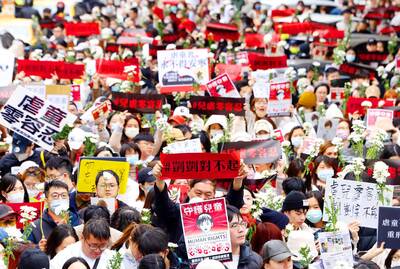
A crowd of over 200 people gathered outside the Taipei District Court as two sisters indicted for abusing a 1-year-old boy to death attended a preliminary hearing in the case yesterday afternoon. The crowd held up signs and chanted slogans calling for aggravated penalties in child abuse cases and asking for no bail and “capital punishment.” They also held white flowers in memory of the boy, nicknamed Kai Kai (剴剴), who was allegedly tortured to death by the sisters in December 2023. The boy died four months after being placed in full-time foster care with the
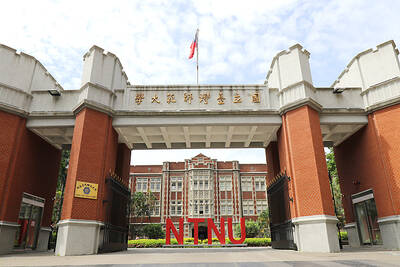
CHANGING LANDSCAPE: Many of the part-time programs for educators were no longer needed, as many teachers obtain a graduate degree before joining the workforce, experts said Taiwanese universities this year canceled 86 programs, Ministry of Education data showed, with educators attributing the closures to the nation’s low birthrate as well as shifting trends. Fifty-three of the shuttered programs were part-time postgraduate degree programs, about 62 percent of the total, the most in the past five years, the data showed. National Taiwan Normal University (NTNU) discontinued the most part-time master’s programs, at 16: chemistry, life science, earth science, physics, fine arts, music, special education, health promotion and health education, educational psychology and counseling, education, design, Chinese as a second language, library and information sciences, mechatronics engineering, history, physical education
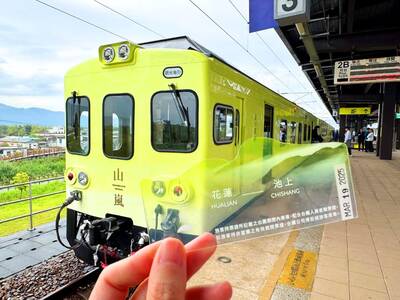
The Shanlan Express (山嵐號), or “Mountain Mist Express,” is scheduled to launch on April 19 as part of the centennial celebration of the inauguration of the Taitung Line. The tourism express train was renovated from the Taiwan Railway Corp’s EMU500 commuter trains. It has four carriages and a seating capacity of 60 passengers. Lion Travel is arranging railway tours for the express service. Several news outlets were invited to experience the pilot tour on the new express train service, which is to operate between Hualien Railway Station and Chihshang (池上) Railway Station in Taitung County. It would also be the first tourism service